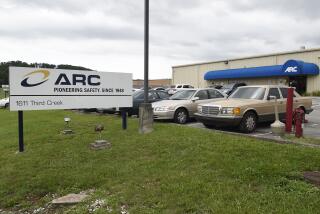Saline Breast Implant Makers Must Prove Safety, FDA Says
- Share via
WASHINGTON — The manufacturers of saline-filled breast implants--the only breast implant still generally available--must prove that their devices are safe enough to remain on the market, the Food and Drug Administration announced Tuesday.
The decision means that the agency intends to put saline implants through the same intense scrutiny given silicone gel implants last year. Both reviews are part of the FDA’s continuing study of medical devices sold before 1976, when Congress gave the FDA the authority to regulate them.
The FDA said that it also will investigate the safety of testicular implants, which are used for cosmetic purposes, and inflatable penile implants, used to treat impotence.
Last year the controversy over the health consequences of silicone gel breast implants inspired an intense national debate that resulted in tight restrictions on their availability. As a result, saline implants became the only real alternative.
Silicone gel implants are permitted now only for reconstructive surgery after breast cancer or to correct deformities. In either case, they must be employed in connection with a large-scale research project. They also are available on a limited basis for cosmetic purposes within small, closely controlled studies.
“As with the silicone implants, we recognize the benefits as well as the potential risks, and we understand the need to balance both,” FDA Commissioner David A. Kessler said in an interview. “The one thing that we care about is getting the safety information to patients. It is absolutely essential that, after 20 years of use, the patient has this information.”
Kessler said that the review process will last about a year.
Possible risks associated with saline implants include infection; hardening of scar tissue around the implant, known as capsular contracture, and interference with mammography.
The implants also can rupture and deflate rapidly, necessitating further surgery. The FDA said that it has received numerous reports of rupture, leakage and deflation of saline implants.
Saline implants are considered safer than silicone gel when they rupture because they contain salt water--a naturally occurring body fluid--that is believed to be harmless. More serious concerns, including autoimmune and connective tissue disorders, as well as cancer, were raised in connection with the rupture of silicone gel devices.
The FDA noted, however, that the saline solution is contained in a silicone rubber shell that may not be entirely without risk to users, the FDA said.
Although there is not enough scientific evidence to establish whether women who have saline implants are at risk for immune-related diseases or cancer, the dangers cannot be ruled out, the agency said.
Saline implants have been on the market for about 20 years and have been used by about 10% of the estimated 1 million women with breast implants. It is unclear how much the market for them has grown since restrictions were imposed last year on silicone gel implants.
“The advertising that we are seeing by plastic surgeons certainly are trumpeting the saline implants, so the numbers have to have jumped,” Kessler said. “But we don’t have the exact numbers.”
The saline implants are manufactured by Mentor Corp. and McGhan Medical Corp., both of Santa Barbara, Calif. Company officials did not return repeated calls Tuesday.
The FDA said that in 1992 it received 1,200 reports on adverse reactions associated with the use of saline implants, compared with 17,000 from the use of the silicone devices. In 1991, the agency had received only 300 reports about saline implant problems, FDA officials said. They attributed the increase in part to heightened publicity about breast implants.
While most surgeons consider the saline implants safer than silicone, no medical devices are risk-free, said Dr. Scott Spear, a plastic surgeon and member of the implant task force for the American Society of Plastic and Reconstructive Surgeons, which represents about 90% of the board-certified plastic surgeons in the country.
The saline implant is “just a balloon filled with salt water--a low-risk implant,” Spear said. “The envelope is made of silicone, but it has to be made of something and there is no absolutely safe material. A silicone envelope is the safest material we know of. . . . I think the saline implants are a reasonable alternative to the gel.”
Rep. Donald M. Payne (D-N.J.), who until recently chaired a House subcommittee that oversees the FDA, said that the agency “has made the same announcement (regarding saline implants) several times in the last year but has not yet done anything about it. I hope the FDA will finally follow through . . . requiring manufacturers to provide these long-overdue safety data.”
The inflatable penile devices are implanted in about 13,000 men annually, the FDA said. The problems associated with them include infections and mechanical failure.
Problems associated with testicular implants “were markedly less than anything we’ve seen with breast implants or penile implants and don’t strike the same level of concern,” Kessler said.
Two types of testicular implants exist, although a silicone gel version was recently withdrawn from the market. The remaining device is a solid version that does not leak, according to Dr. David McLeod, a spokesman for the American Urological Assn.
McLeod and Kessler said that the devices should not be removed at this time, unless problems have developed.
“In the absence of rupture or complication, if the prosthesis is in place, the risk of removal may be greater than the risk of allowing it to remain in place,” McLeod said.





